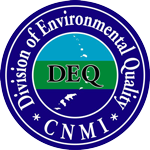
Hafa Adai and Tirow! Welcome to the Division of Environmental Quality - Bureau of Environmental and Coastal Quality website.
Wastewater, Earthmoving, Erosion Control Branch
DEQ's Wastewater, Earthmoving and Erosion Control branch protects public health and the environment by minimizing negative impacts to CNMI soil surface and ground water resources through enforcement of local and federal environmental regulations.
This branch is responsible for controlling runoff from human related activities, ensuring proper design, construction and application of approved on-site wastewater disposal systems, responding to complaints on illegal and or unpermitted land clearing, issuing notices of violations and administrative orders and promoting public education and awareness
Publications
Press Release: Earthmoving & Erosion Control Rules and Regulation
BECQ-DEQ is announcing revisions to its earthmoving regulations that were adopted on June 7, 2014, after being published for public comment in the Commonwealth Register on February 28, 2014.
The following are the keys changes made:
- The reference to landscaping for small projects has been removed. Instead, all projects less than 100 meters and with a grade less than 3% will not be required to obtain a permit.
- All maps and site-plan drawings for commercial projects must be prepared using a computer-based drawing tool such as Auto-CAD.
-
A certified Erosion Control Specialist must oversee and
implement the temporary erosion control plan for all commercial
projects. An Erosion Control Specialist is any person who has
met the following requirements:
- The person has completed the application to register as a DEQ-certified Erosion Control Specialist, or has renewed a previously approved certification.
- The person has paid the necessary application fee or renewal fee.
- The person has passed the DEQ-administered “Erosion & Sediment Control Certification Exam” with a score of 70% or better.
- The person has not demonstrated a history of noncompliance with the DEQ Earthmoving & Erosion Control Regulations.
-
The fee structure for commercial permit applications has been
revised as follows:
- Project Area/Fee
- Up to 1 hectare - $150.00
- Greater than 1 hectare less than or equal to 5 hectare - $450.00
- Greater than 5 hectare less than or equal to 15 hectare - $850.00
- Greater than 15 hectare less than or equal to 50 hectare - $3,000.00
- Greater than 50 hectare less than or equal to 100 hectare - $6,000.00
- Greater than 100 hectare less than or equal to 200 hectare - $10,000.00
- Greater than 200 hectare - $15,000.00
- Non-commercial applications, with the exception of work performed by the government, shall be charged an application fee of $25.
- The standards set forth in 2.1 and 2.2 of the 2006 CNMI and Guam Stormwater Management Manual are adopted by reference into the regulation.
- After a permit has been approved and issued, each amendment to a commercial application shall result in a fee of 50% of the original permit application fee.
The above Commercial and Non-commercial fee schedule will be in effect on September 2, 2014. For detailed information, please call the Wastewater, Earthmoving & Erosion Control Branch at 664-8500.
FUNCTIONS
Wastewater
The Wastewater Treatment and Disposal program ensures proper design, construction and application of approved on-site wastewater disposal systems. Individual Wastewater Disposal System (IWDS) are systems designed for individual homes (and some commercial and business facilities) to dispose of wastes through septic tanks, leaching fields or seepage pits. Other Wastewater Treatment Systems (OWTS) are systems designed and installed to treat and dispose of sewage from a single structure or group of structures other than septic tanks together with leaching fields or seepage pits. This branch ensures that waste from these systems:
- Do not contaminate any drinking water supply.
- Are not accessible to insects, rodents, or other possible carriers of disease, which may come into contact with food or drinking water.
- Do not pollute or contaminate any waters used for public or domestic water supply purposes or for recreational purposes.
- Are not a health hazard, by being accessible to children.
- Do not give rise to nuisances due to odor or unsightly appearance.
- Will not violate any local laws or regulations governing water pollution or sewage disposal.
This branch is also responsible for reducing the direct and indirect discharge of untreated animal waste to state water and groundwater through use of components and practices (such as septic tanks, leach field, waste storage ponds, waste utilization, composting or other methods). A confined animal facility means a lot or facility (other than an aquatic animal production facility) where the following conditions are met:
- Animals (other than aquatic animals) have been, are, or will be stabled or confined and fed or maintained for a total of 45 days or more in any 12-month period, and
- Crops, vegetation forage growth, or post-harvest residues are not sustained in the normal growing season over any portion of the lot or facility.
Facilities are requested to construct and operate an Other Wastewater Treatment System (OWTS) if they contain any of the following number of head:
- 15 or more pigs
- 20 or more goats
- 10 or more cattle
- 100 or more chickens
- OR, any confined animal facility which had been found by the Division of Environmental Quality (DEQ) to have caused, by evidence of direct or indirect discharge, in violation of the CNMI Water Quality Standards or CNMI Drinking Water Regulations.
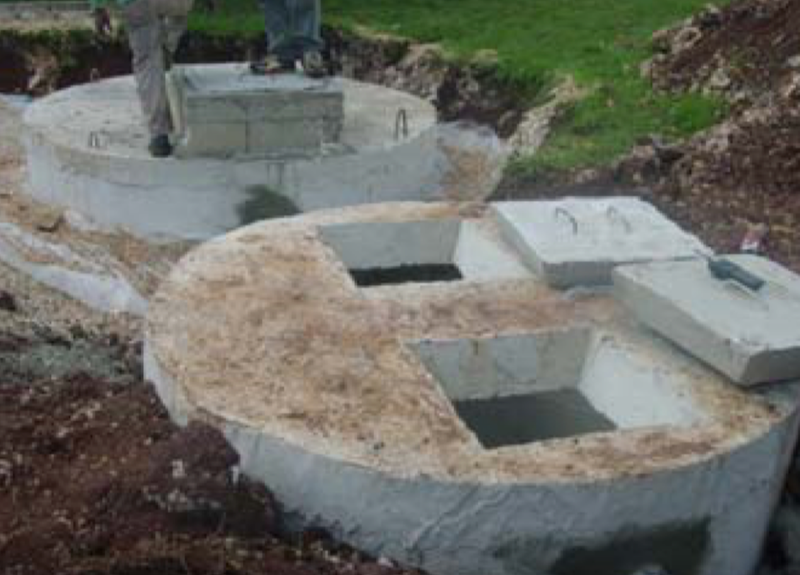
Large confined animal facilities (more than 100 heads of pigs, 1000 chickens, or 50 cattle) may be required to meet more stringent requirements which is determined on a case-by-case basis. Runoff includes any precipitation (rain or snow) that comes into contact with any manure, litter, or bedding. Facility wastewater is water discharged in the operation of an animal facility as a result of any or all of the following: animal or poultry watering; washing, cleaning, or flushing pens, barns, manure pits, or other animal facilities; washing or spray cooling of animals; and dust control.
Permitting
Residents and industries are required to submit a permit application for either Individual Wastewater Disposal Systems (IWDS) or Other Wastewater Treatment Systems (OWTS). Septic System and Wastewater Pumpers or any person engaged in the business of cleaning IWDS or disposing of the waste must also complete a Septic System and Wastewater Pumper Application. For convenience, here are the Septic Tank Requirements. Once an application is received, it is reviewed for all required data (percolation rate, daily sewage flow, system size and capacities). Staff will conduct a pre-inspection of project site to check and verify setback requirements. The permitting process is within a 30-day period upon receipt of the complete application package, including an intensive review of system plans, designs and calculations. Permits are issued for the purpose of constructing IWDS or OWTS with construction to begin within 90days of permit issuance. During construction stage of disposal system, staff will continue to monitor developments until the project has been completed. Upon final inspection by staff, a Certificate For Use (CFU) shall be issued to the permittee.
Regulations
The Wastewater Treatment Rules and Regulations CR Vol. 24, No. 11, November 27, 2002 (CNMI Environmental Protection Act, Public Law 3-23, 2 CMC §§ 3101 et seq. (as amended by P.L. 11-103), 1 CMC §§ 2646 to 2649, and Public Law 11-108); Northern Mariana Islands Administrative code chapter 65-120, Wastewater Treatment and Disposal regulation; are available at the end of this article. It can also be accessed in the Permits and Regulations section of this website.
MANUALS
Earthmoving and Erosion Control
The Earthmoving & Erosion Control program is responsible for establishing certain minimum standards and requirements as determined by the Division necessary for controlling nonpoint source runoff from human related activities, such as land clearing.
Earthmoving activities, means any construction or other activity which disturbs or alters the surface of the land, a coral reef, the bottom of a lagoon, or ocean floor, including but not limited to excavations, dredging, embankments, land reclamation in a lagoon, land development, subdivision development, mineral extraction, ocean disposal and the moving, depositing or storing of soil, rock, coral, earth or sand mining.
The Northern Mariana Islands Administrative Code (NMIAC) Chapter 65-30, § 65-30-101; Permit Requirements, "No person shall commence or continue any earthmoving activity including grading, filling, or clearing of vegetation without a DEQ Earthmoving and Erosion Control Permit issued in accordance with the regulation".
Erosion Controls are methods or measures used to minimize erosion, runoff and sedimentation. Commonly used erosion controls are silt fences, earthberms and ponding basins. Soil erosion is an important social and economic problem and an essential factor in assessing ecosystem health and function. Estimates of erosion are essential to issues of land and water management, including sediment transport and storage in lowlands, reservoirs, and most especially our precious lagoon. The deposition of sediment into a waterway can significantly diminish the water quality and aquatic habitat. Sediment deposition in a waterway makes the water more turbid and does not allow as much light to penetrate the water. This causes problems for aquatic plants that need sunlight in order to perform photosynthesis.
Furthermore, suspended sediments in the water have the potential of clogging the gills of aquatic organisms and covering the stream bottom. Deposition of sediment on the stream bottom can lead to the suffocation of fish eggs and benthic macro invertebrates. which could cause the destruction of natural spawning substrate. Also, with an increased amount of particles in the water, dissolved oxygen levels are reduced because of higher water temperatures.
Stormwater Management
To improve upon current stormwater management practices, a Stormwater Management Report was developed, identifying a set of unified criteria to provide proposed standards to augment groundwater recharge to achieve water quality protection, prevent accelerated stream channels, prevent erosion, reduce flooding threats, and preserve sensitive habitats.
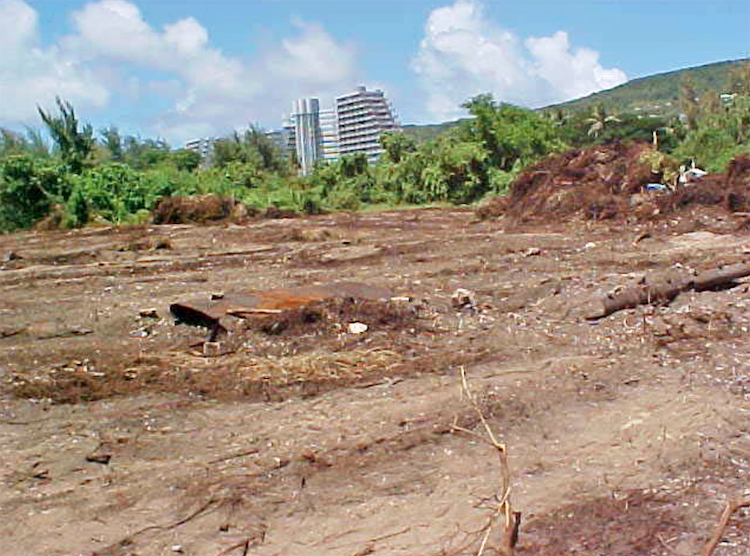
A manual was also developed. The manual is a compilation of hard-won knowledge and experience into a single comprehensive design handbook that is useful to engineers, plan reviewers and the regulated community. Most importantly, the Manual should provide a framework to ensure the effective implementation of stormwater management practices to protect the vital water resources of Guam and the Northern Mariana Islands.
Volume I of the Stormwater Management Manual provides designers a general overview on local stormwater issues, lists the stormwater performance standards for the islands, and describes how to size and design BMPs to comply with those standards.
Volume II of the Stormwater Management Manual contains more detailed information on how to select and locate BMPs at a development site, how to prepare effective landscaping plans for stormwater practices, BMP construction specifications, step-by step BMP design examples and other assorted design tools.
Permits and Regulations
This branch reviews and manages the Inter-Agency One-Start Earthmoving and Erosion Control Permit application for both Commercial and Non-Commercial, and Application to Receive / Haul Excavated Materials (Less than 45 cy). Any land clearing activity requires this permit. By Law (2 CMC Div. 3 §3122 (f)(1)) the Earthmoving and Erosion Control permitting process must be completed within 21 calendar days. The Earthmoving and Erosion Control Regulations CR Vol. 15, No. 10, October 15, 1993 (CNMI Environmental Protection Act, Public Law 3-23, 2 CMC §§ 3101 to 3134, and 1 CMC §§ 2601 to 2605); NMIAC chapter 65-30 Earthmoving & Erosion control Regulations; are available at the end of this page. It can also be accessed in the Permits and Regulations section of this website.
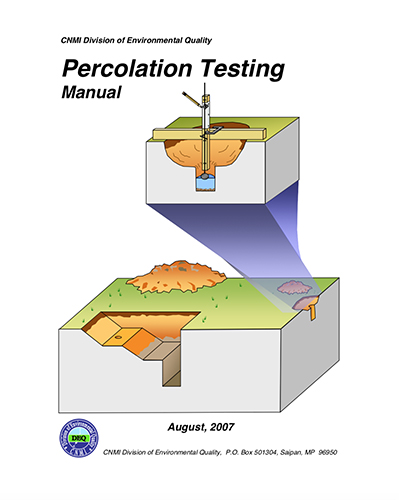
Perculation Testing Manual
Interim Guidance For Performing Percolation Tests
This manual is meant to serve as ― interim ‖ guidance to persons performing percolation tests in support of DEQ ―IWDS‖ and ― Earthmoving and Erosion Control ‖ permit applications. ― Interim ‖ means that this manual is meant to serve as temporary guidance until such time DEQ updates its regulations and requirements, which may occur within the next few years. The procedures outlined in this manual are based primarily on the existing DEQ regulations governing the performance of percolation tests (found in Section 10 of the CNMI Wastewater Treatment and Disposal Regulations, 24 Com. Reg. 11, Nov. 27, 2002, starting at page 19800). However, in recognition of changing best practices in percolation testing, a number of changes have been made to the DEQ procedures in this document.
Programs
Percolation Testing
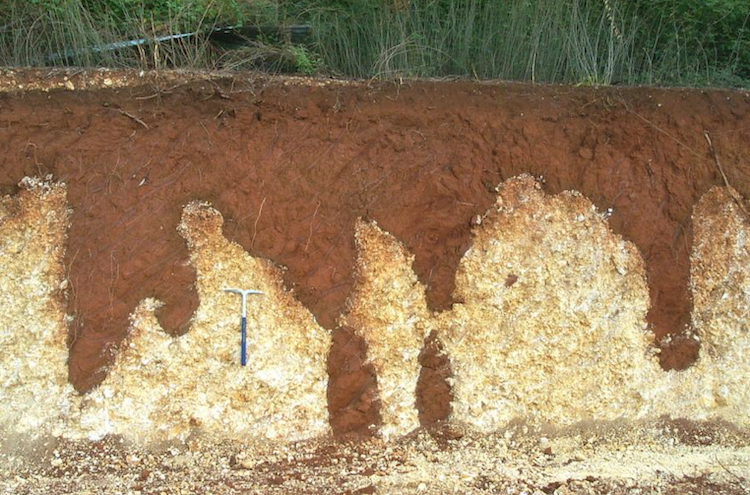
Typical limestone / soil interface. 6-inch percolation test pits just a foot or two apart can give very different percolation rates. (Photo courtesy Bob Gavenda, NRCS)
Percolation testing involves investigating the soils at a particular location and determining the site’s suitability for the disposal of wastewater or stormwater. A percolation test is always required for any new septic system (“individual wastewater disposal system” or “IWDS”), and is almost always required for earthmoving and erosion control (“One Start”) permit applications.
Why are percolation tests required?
Percolation tests provide critical information for the sizing of septic systems and stormwater “ponding basins” because those types of systems rely on the ability of soil to absorb water. If a percolation rate is just guessed at, or a contractor fails to notice restrictive soil conditions, the final result may be a system that fails 6 months after it is built, or a system that is built larger and more costly than necessary. Although the cost of a percolation test may seem like an unpleasant expenditure, it is far less than the cost of replacing a failed leaching field, or the construction of an over sized stormwater infiltration system.
How to obtain a percolation test
Starting in July 2007, DEQ began requiring that all percolation tests must be performed by qualified individuals. A qualified percolation tester is a person who has attended training provided by DEQ and passed an examination proving their knowledge of percolation testing procedures and basic soils information. If you are paying for a percolation test, make sure the tester has been authorized by DEQ first – they can show you a numbered certificate if you ask. For most single-family homes, only one percolation test pit is required. For other types of projects, three or more percolation test pits are required in order to obtain good results. Additionally, in certain types of soils a “deep observation pit” may need to be dug, in order for the percolation tester to obtain enough information to make their final design recommendations.
How can one become certified to perform percolation tests?
In order to be allowed to perform percolation tests for submittal with DEQ permit applications, one must first be able to show DEQ their ability to perform the test according to established procedures, and they must be able to pass an examination proving they fully understand the procedures and requirements. DEQ occasionally conducts workshops, which for the most part has resulted in the authorization of most companies and individuals advertising percolation testing services in the CNMI (as of September 26, 2007). Future workshops may be conducted as more requests are received for training, or as refreshers for those already certified. Call the DEQ Wastewater Earthmoving & erosion control Branch for more information regarding future workshop schedules. Self-study is also a way to obtain certification. The DEQ Reference Manual is available for free download by clicking the following link: CNMI Percolation Testing Manual and contains enough information, including a sample exam, to prepare for the exam. Depending on availability of staff, an interested person can schedule an examination at DEQ which would include taking the written examination with a passing grade pf 70 and above, as well as demonstrating proficiency at the actual test procedures.
Staff and Management
- Merrill O. Ayuyu - Branch Manager
- Josh S. Duenas - One Start Program Coordinator
- Augustin Camacho - Environmental Specialist
- Valerie Hofschneider - Environmental Technician
- Jonathan Cabrera – Environmental Technician
- Jason Reyes -Environmental Technician
- Eblai Ulechong - Administrative Assistant